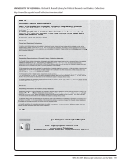84 · Survey Results: Survey Questions and Responses
“ExLibris–Aleph.”
“Federated searching is handled by Webfeat.”
“GAMMS has many search functions.”
“I don’t have the name of the software we are using now, but we plan to move to DLXS in the next few months.”
“I’m not sure that it qualifies as ‘special software,’ but the site has a general search engine that searches across
the documents but that does not particulate elements.”
“In-house DBTextWorks network fast and flexible searching.”
“InQuery (aka Aurora), licensed from Chiliad Publishing, but no longer supported. Full text search, primarily used
at LC for American Memory indexing.”
“No need — EAD formatting permits searching using the browser.”
“On the OAC: For search and delivery of EAD finding aids, the OAC utilizes the CDL-developed eXtensible Text
Framework (XTF) system. For search and delivery of TEI-encoded texts, the OAC utilizes the CDL-developed XTF
system. Text searches are limited to the full text of the documents. For search and delivery of image metadata, the
OAC utilizes the CDL-developed XTF system.”
“Online Archive of California.”
“Part of the Online Archive of California.”
“Primo.”
“Re:discovery for the Internet.”
“Tamino, an XML search engine.”
“The Digital Library Extension Service: DLXS software consists of two components. The first component is the
DLXS middleware, available as a free Open Source resource. The second component is the XPAT search engine,
available in two versions. One version of the search engine (XPAT) is licensed and available for a fee. The other
version (XPAT Lite) is freely available but has a limit on the size of the data which can be indexed. Additional
information is available at http://www.dlxs.org/products/index.html.”
“We are implementing PRIMO which is expected to provide this capability for our html files as well as
bibliographic database and leased electronic products.”
“We are in development to use CONTENTdm to display finding aids after we create a map from the database to
DC fields.”
“We have recently implemented XTF search software that we obtained from the Online Archive of California and
adapted for our use.”
“Well yes, in the sense that researchers can do this with our MARC records in our local OPAC or in World Cat.”
“XPat.”
“XTF from California Digital Library. The indexing part of XTF is based on Lucene, a common XML indexing tool.”
“ExLibris–Aleph.”
“Federated searching is handled by Webfeat.”
“GAMMS has many search functions.”
“I don’t have the name of the software we are using now, but we plan to move to DLXS in the next few months.”
“I’m not sure that it qualifies as ‘special software,’ but the site has a general search engine that searches across
the documents but that does not particulate elements.”
“In-house DBTextWorks network fast and flexible searching.”
“InQuery (aka Aurora), licensed from Chiliad Publishing, but no longer supported. Full text search, primarily used
at LC for American Memory indexing.”
“No need — EAD formatting permits searching using the browser.”
“On the OAC: For search and delivery of EAD finding aids, the OAC utilizes the CDL-developed eXtensible Text
Framework (XTF) system. For search and delivery of TEI-encoded texts, the OAC utilizes the CDL-developed XTF
system. Text searches are limited to the full text of the documents. For search and delivery of image metadata, the
OAC utilizes the CDL-developed XTF system.”
“Online Archive of California.”
“Part of the Online Archive of California.”
“Primo.”
“Re:discovery for the Internet.”
“Tamino, an XML search engine.”
“The Digital Library Extension Service: DLXS software consists of two components. The first component is the
DLXS middleware, available as a free Open Source resource. The second component is the XPAT search engine,
available in two versions. One version of the search engine (XPAT) is licensed and available for a fee. The other
version (XPAT Lite) is freely available but has a limit on the size of the data which can be indexed. Additional
information is available at http://www.dlxs.org/products/index.html.”
“We are implementing PRIMO which is expected to provide this capability for our html files as well as
bibliographic database and leased electronic products.”
“We are in development to use CONTENTdm to display finding aids after we create a map from the database to
DC fields.”
“We have recently implemented XTF search software that we obtained from the Online Archive of California and
adapted for our use.”
“Well yes, in the sense that researchers can do this with our MARC records in our local OPAC or in World Cat.”
“XPat.”
“XTF from California Digital Library. The indexing part of XTF is based on Lucene, a common XML indexing tool.”








































































































































































































